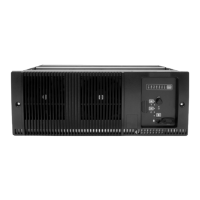TB9100/P25 CG/P25 TAG Installation and Operation Manual Technical Description 135
© Tait Limited March 2014
Power Supply
The control panel is powered from the subrack interconnect board. 28VDC
is supplied to the subrack board from the PMU (if fitted). If no PMU is
fitted, 10.5VDC to 32VDC is supplied to the subrack board from the DC
input connector at the rear of the subrack. The power supply for the cooling
fans mounted on the front panel is fed through the control board. When
power is applied to the subrack, the control panel will default to reciter
position 1.
8.6 System Control Bus
The system control bus provides the following physical paths:
■ I
2
C communications between modules
■ RS-232 communications between the reciter and Calibration Software
■ fan power from the PA and PMU
■ speaker and microphone signals to and from the control panel
■ power connections for the control panel.
The system control bus has been designed so that, if a major fault occurs on
the bus, the basic operation of the base station is unaffected, but some
features will not operate correctly. For example, if the PA is disconnected
from the bus:
■ the ‘PA not detected’ alarm is generated in the reciter; however,
transmission still takes place because the transmit RF and key signals are
transmitted from the reciter to the PA via the interconnecting coaxial
cable
■ the PA is unable to turn on its fan. Depending on the ambient
temperature at the site and the transmit duty cycle, this could allow the
PA to heat up to the point where it reaches the upper temperature
threshold. At this point it will begin power foldback, protecting the
equipment from damage.
The PMU behaves in a similar way to the PA.
The system control bus has been designed to operate only within the
subrack. It has not been designed for use outside the subrack or to
interconnect two subracks.
I
2
C Signals The base station uses the I
2
C bus and a proprietary software protocol to
provide communications between any modules connected to the bus.
Typically this involves the reciter assuming ‘server’ status, and PA and PMU
‘client’ status. The reciter co-ordinates the entire subrack operation, reading
from and writing to all modules, including the control panel. The I
2
C bus
allows the reciter to perform the following functions:
■ monitoring (e.g. operating status, module details, operating temperatures
etc.)
■ diagnostics (execution of tests to confirm correct operation)

